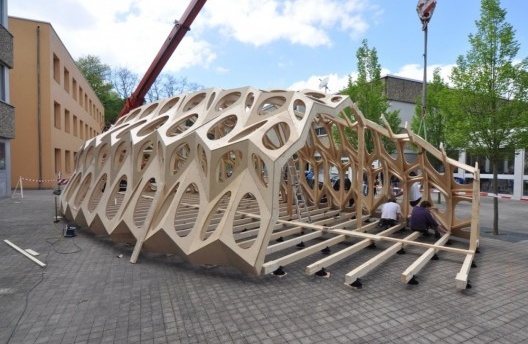
BOWOOSS, Summer pavilion [Foto divulgação]
GC: Now I would like to ask you a question regarding education. You did not get you professional degree in Germany, but you earned you PhD at the University of Stuttgart, and you have been teaching also at Stuttgart and in Graz. What is your opinion about architectural education in Germany? Is it still traditional, or are students already getting ready for the situation that you have just described, with the automation of the whole process?
MD: I don't think it is traditional. Many students see what is going on and they try to do it themselves very early, with Grasshopper and stuff like that, even in the first or second year of studies. As far as I have seen the faculty responds to this. They offer them the courses they want, and there are institutes on that.
GC: What about digital fabrication? Are the machines available?
MD: No so early, but a bit later they are available for them. The schools have CNC machines and laser cutters. 3D printers now mostly... we have a robotic arm (at the University of Stuttgart), and people at TU Graz bought three robotic arms, not so large as in Stuttgart, though.
GC: Do you think that this is just happening at the top technical-oriented universities or it is widespread in most schools of architecture?
MD: I don't know if it's widespread, but I think it is pretty spread. I have been mostly in Stuttgart and Graz and they are considered top schools (for that). But I was also teaching at Saarbrücken with Pohl Architects (http://www.pohlarchitekten.de/), with whom I'm cooperating, and you are right, they were not so familiar to it. But always out of 20 students there is at least some that are interested in Grasshopper and programming.
GC: But this is not included in the curriculum, right?
MD: Not, usually not. But I'm very skeptical about how it should be implemented. I approach programming as a tool not for playing around, but as a tool for automating and making serious work. But for what I have seen, it's only playing. They are using Processing, Grasshopper, for exploring in a not useful way. The product of this exploration is usually just some pretty pictures.
GC: Do you think it's because the professors are still learning about it? They still are not sure about what can be done with it…
MD: That's one of the main reasons. These institutes (or labs) are opening all around the world, like the Institute for Computational Design at the University of Stuttgart. I have the feeling that the head of these institutes are people who come more from theory than from practice. I cannot say if that's better or not. From my point of view that's not good. They themselves don't know how to program at a high level. They get PhD students who do know something and they try to do it over them, somehow. But without the understanding of what is possible, usually the products are not so satisfying. Here in Stuttgart it is maybe a bit better because they are building these pavilions...you can actually see some applications. But my bias is that in Stuttgart this all happened because of (Prof. Jan Knipper's Institute of Building Structures and Structural Design, ITKE), where I studied, because they brought the applicability, they do the static analysis and think about the production. In most cases you don't have this type of partnership. If you just Google parametric design and go to images, there is no built object. There are only pictures of infinite parametric objects and some ZahaHadid organic shapes, which are not really parametric design. I am familiar with many of those buildings and although there are many explorations done in Grasshopper, at the end they discover the limits of those software and they do it manually, because they don't have time (to implement it). True parametric design is very rare. From what people consider to be parametric design in the world 95% has nothing to do with it.
GC: And what do you think about the role of structural analysis in architectural education?
MD: Students here don't know enough. But I don't know how much is enough. Everything is becoming so complex that you cannot cover everything. There is this famous joke about architects and engineers. Architects tend to know less and less about more and more, until they know nothing about everything, while engineers tend to know more and more about less and less, until they know everything about nothing. In architectural education something has to be decided, if you want to continue on this way or not. The field is becoming so big. Structural design is becoming so complex, parametric design is becoming so complex, programming is so complex... do you really want to cover all this? Then you are going to become someone who knows very little about many things. And if you go out of the University like that I don't think you are prepared to do anything. I think that you should choose your direction very early, like after one year of study. You have to choose. I want to go on programming, I want to go more into structural design, etc. And then you have other four years of specific training. In parametric design, if you have only one semester of playing with Processing or Grasshopper forget about it, that's nothing. For me that's kindergarten, just playing with models, and that's it. If you want to program seriously, then do it for four years. Learn aa, learn C++, learn C# and then do something applicable, do some automatization, do some automatic blueprints. But if I do it for just one semester, creating some infinite spheres, playing some swarming in Processing, it's a play, like in kindergarten, but then you go outside and need to design a building and it's very complicated. In some studios or offices they can afford that. I have a friend who works for ZahaHadid and they can afford to play a lot. They have like some six months of research when they do some abstract programming and scripting, and theoretically at the end they get the design out of it. But I'm not so sure... it's just the process of playing and I don't see the applicability, there is so much fog in it. I am more like an engineer...

BOWOOSS, Summer pavilion [Foto divulgação]



